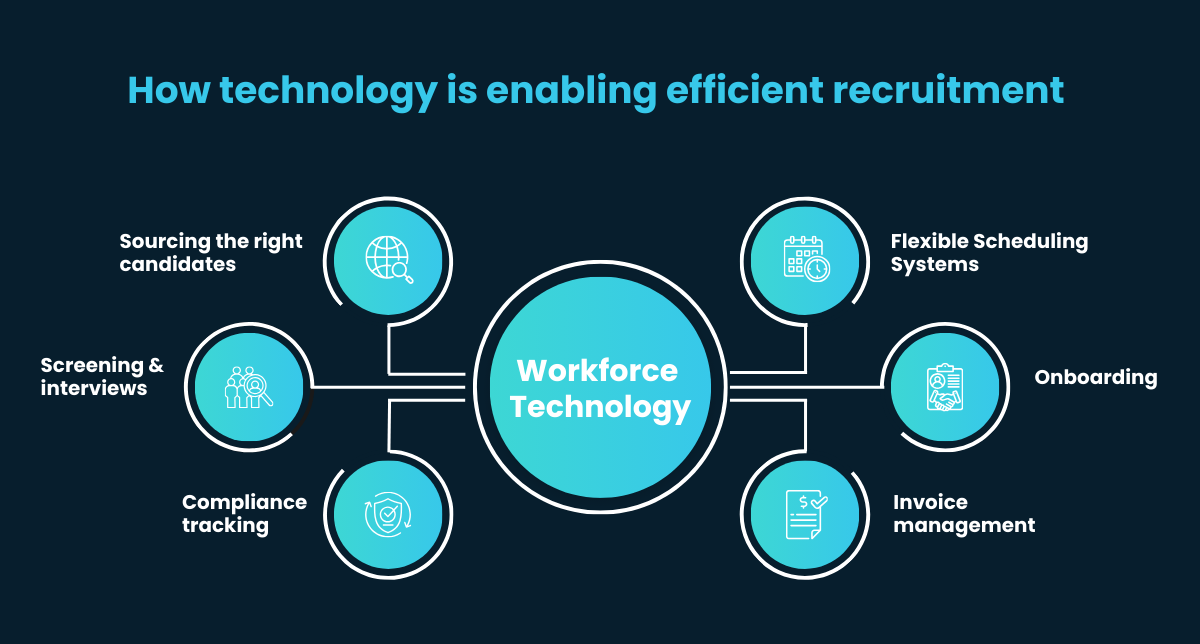Top Healthcare Workforce Trends to Watch in 2025

As we welcome 2025, it’s clear that healthcare is heading into a year of change—and we’re optimistic on what lies ahead! According to a survey by Deloitte’s Center for Health Solutions, nearly 60% of healthcare leaders share this outlook, anticipating growth in revenue and profitability. This year has the potential to bring strategic growth and exciting innovation to healthcare teams everywhere. In this blog, we’re diving into the top healthcare workforce trends for 2025 and how they’ll help build stronger, more resilient teams.
1. Flexible Work Models and Telehealth
Flexibility and remote are now staples across industries—and yes, that includes healthcare! By embracing remote and hybrid work models, healthcare organizations address key workforce challenges, like staffing shortages and employee burnout. Virtual care allows professionals to provide diagnostic services, consultations, monitor conditions, prescribe medications, and more—all from virtually anywhere. This helps reduce strain on in-person facilities and alleviate workplace shortages. The added bonus? Flexible work models allow clinicians to enjoy better work-life balance and greater job satisfaction, leading to a more engaged and motivated workforce.
Is flexible scheduling a goal for your organization this year? Discover our app that empowers clinicians to build their schedules while maintaining seamless care delivery. Talk to us here!
2. Workforce Shortages: A Long-Term Reality
Workforce shortages are still a very real problem and are expected to persist well into the next decade according to the BLS, AHA, HRSA, and the AAMC. Across the U.S., registered nurses, physicians, and nursing assistants are among the hardest-hit roles, with projections pointing to severe shortfalls.
For example, the BLS projects that there will be a total of 197,200 registered nurses entering the field by 2033, while job openings for RNs will be at 194,500 annually, meaning 197,200 nurses will barely be enough to cover just a single year's needs. Similarly, the AAMC predicts up to 86,000 fewer physicians by 2036, while HRSA estimates a shortage of 187,130 across all specialties by 2037. Nursing assistants face similar challenges, with Mercer forecasting a shortage of 73,000 by 2028 and the BLS estimating only 64,700 will enter the field by 2033.
So, why is the gap widening? A combination of factors is driving these shortages which include:
- An aging workforce nearing retirement
- Rising medical needs from an aging population
- Fewer graduates entering the field
- Widespread clinician burnout
- Financial constraints on health systems
What does this mean for 2025? Hospitals and health systems will need to get creative. Mitigating shortages requires a multifaceted approach, including:
- Strengthening Employee Value Propositions (EVPs) with competitive pay, flexibility, and employee well-being initiatives
- Partnering with schools and training programs to fast-track new talent
- Offering clear career paths with opportunities for growth and professional development
- Leveraging workforce solutions and technology to optimize staffing and streamline operations
Want deeper shortage insights and strategies? Check out our latest analysis on the state of healthcare workforce shortages for fresh data and creative solutions hospitals are adopting.
3. The Expansion of AI & Data-Driven Workforce Management
It might feel obvious to talk about AI’s importance in today’s world, but its impact on healthcare is impossible to ignore. From diagnosing diseases to analyzing historical data for predictive insights and streamlining processes, AI is doing it all. In fact, a Microsoft 2023 study reports that 79% of healthcare organizations are already leveraging AI technology.
The importance of AI in workforce management and recruitment is no exception. With health systems identifying cost efficiency and productivity as top priorities for 2025, AI is stepping up to help. By forecasting staffing needs, optimizing schedules, and automating end-to-end recruitment processes, AI is laying the groundwork for greater efficiency and faster role fulfillment.
Don’t just take our word for it. According to the American Hospital Association’s (AHA) 2025 Artificial Intelligence Action Plan for Healthcare, 85% of health system leaders cited AI as the technology they're most excited about. Meanwhile, Deloitte found that 60% of healthcare executives anticipate adopting new technologies in 2025, with 53% expecting generative AI to play a key role in their strategies.
Here are two key ways AI is reshaping workforce management:
- Predictive Analytics for Workforce Planning: By analyzing historical data, patient demand trends, and external factors, predictive analytics anticipates staffing needs, helping health systems address shortages and optimize staff levels before gaps arise.
- AI-Driven Recruitment: Hiring healthcare professionals is time-intensive, with roles like neurosurgeons taking up to 344 days to fill. AI-powered tools streamline recruitment by automating tasks like sourcing, screening, compliance tracking, and scheduling. This not only saves time but also improves the candidate experience, reducing delays and communication barriers to secure top talent efficiently.
Workforce Technologies to Automate and Streamline Operations
- Vendor Management Systems (VMS): VMSs, like our StaffBot VMS, centralize recruitment and workforce management within a single platform. These tools automate tasks, track compliance, integrate data analytics, and provide market rate insights for specialties—enhancing efficiency and informed decision-making.
- Scheduling App: Scheduling apps are revolutionizing staffing optimization. These tools give clinical employees the power to manage their own schedules, self-schedule open shifts, and foster better work-life balance while reducing administrative burdens.

4. Develop Your Talent with Upskilling and Continuous Learning
In the coming year, healthcare organizations will be doubling down on upskilling and continuous learning to stay ahead of evolving needs. Training and upskilling hold massive potential for addressing both workplace shortages and promoting retention. Hear us out—rather than just focusing on hiring new talent with the right skillsets (which we know is ideal, but not always easy), consider identifying gaps within your current teams. By providing opportunities to upskill and train existing staff, you can address these gaps while strengthening your team. Train employees on emerging technologies, create leadership roles and support team members as they advance into new specialties. This approach not only helps fill hard-to-staff positions but also invests in the growth of your own workforce.
Even better, this strategy pays off. Investing in employees’ development fosters retention. Korn Ferry found that 67% of employees would stay with an organization if offered opportunities for advancement and upskilling.
5. Tackling Burnout and Prioritizing Well-being
Shortages and turnover continue to fuel burnout—and understandably so. Burnout remains a major challenge, wearing down core employees and running rampant within hospital walls. The AHA’s most recent 2025 Workforce Scan highlighted that while burnout and turnover have dropped for the first time since the pandemic, they remain major contributors to shortages and a burden on employees that can’t be ignored. This year, institutions will continue to invest in mental health support and wellness programs, while seeking solutions to improve work-life balance. A healthier, happier workforce doesn’t just boost retention—it directly enhances patient outcomes and experiences.
6. Prioritizing Diversity, Equity, and Inclusion (DEI)
A core pillar of this year’s workforce approach will be a strong focus on Diversity, Equity, and Inclusion (DEI). Integrating DEI initiatives isn’t about making strategic moves, it’s the right thing to do. A workforce that reflects the communities it serves fosters innovation and improves patient outcomes. Diverse teams enhance collaboration, foster greater understanding among colleagues of different backgrounds, and help minority employees feel valued and safe.
By prioritizing DEI, health organizations are not only advancing equity but also positioning themselves to deliver better care, elevate patient experiences, and cultivate a culture of inclusivity and understanding.
7. Growth of Locum Tenens, Nurse Practitioners, and Physician Assistants
As we’ve discussed, physician demand is expected to grow, which is driving the rise of the locum tenens as a flexible solution for healthcare organizations. The SIA reported a 12% growth in locum tenens last year, with an expected 5% increase in 2025. This growth is primarily driven by an aging population requiring more care amid looming physician shortages.
Luckily, physicians are increasingly looking to the aid of nurse practioner’s (NP) and physician assistants (PA) to take over care. These advanced practioner’s are increasingly stepping in to provide advanced care that were once traditionally overseen by physicians. This assistance helps alleviate shortages and pressures faced by physicians. In fact, there’s projected growth for NPs and PAs, with the U.S. BLS projecting 45% and 27% growth respectively.
8. Increasing Inflation and Costs
Inflation is hitting hard. Between 2021 and 2023, inflation jumped 12.4%. For health systems this means increased operational costs, supplies, and labor wages. Drug and supply costs alone rose 15.2% from 2022 to 2023, while inflation pushed labor expenses to an astonishing $42.5 billion during the same period. To counteract these challenges, hospitals are focusing on two key strategies:
- Improving workforce efficiencies
- Developing cost-sustainable workforce models, including reducing contingent labor
Improving Workforce Efficiencies:
Technology and workforce programs will play a significant role in streamlining operations and automating routine tasks. Automating recruitment processes—such as screening, compliance, and onboarding—will be necessary to maximize the value of recruitment teams while controlling costs.
Developing Cost-Sustainable Workforce Models:
Over-reliance on contingent labor has placed significant financial strain on hospitals. Although travel rates have stabilized since their 2022 peak, they remain high. In 2025, hospitals will prioritize sustainable workforce models by building permanent teams, optimizing internal staff, or establishing internal staffing agencies to manage external labor. Tailored workforce solutions will be key to containing costs and fostering a more stable, resilient workforce.
How Adapting to Trends Will Help Fill Staffing Gaps
By embracing these trends, you’ll effectively address the key challenges health systems face today: attracting and retaining the right talent, building a resilient and sustainable workforce, and optimizing long-term staffing strategies.
The focus will be on valuing and nurturing your current team while thinking creatively about how to attract new talent. It means adopting new workforce models that don’t solely rely on temporary staff. It means leveraging technology to optimize every aspect of workforce management to improve team dynamics, streamline day-to-day operations, and—most importantly—enhance patient outcomes.
It can feel overwhelming knowing where to start. We’re not saying your organization needs to tackle all of these changes at once, but beginning with small, actionable steps will create momentum.
And if it feels overwhelming, we’re here to help!
Our workforce team (with 45+ years of combined experience, might we add 😉) leads top healthcare systems in optimizing workforce strategies. We create a tailored approach for each of our partners to help streamline processes, provide scheduling flexibility, build a long-term workforce, oversee recruitment, build internal staffing teams, or simply consult your teams.
If your hospital is looking for impactful changes this year, speak to our amazing team! Fill out the form for a quick chat about your challenges and how we can tackle them, together.
Looking for more insights like this? This article is also featured on our LinkedIn Newsletter! Connect with us there for ongoing updates and discussions on healthcare workforce solutions!
